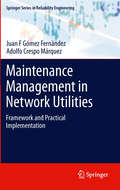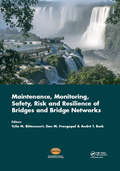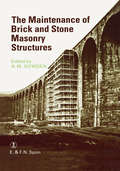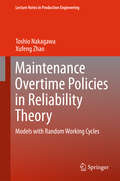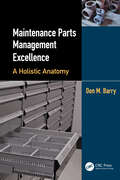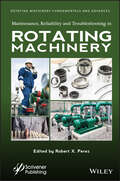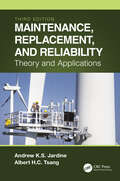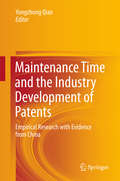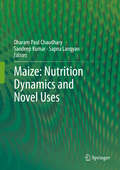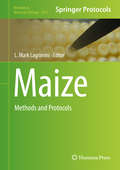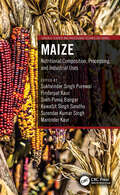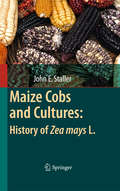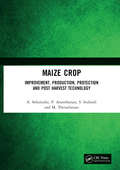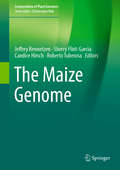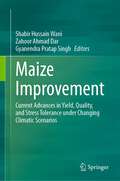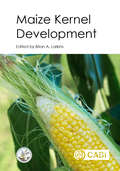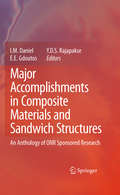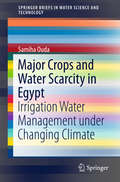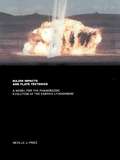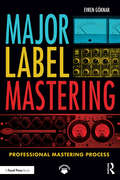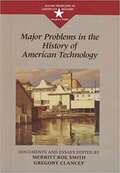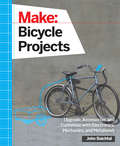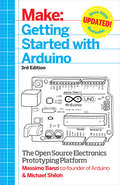- Table View
- List View
Maintenance Management in Network Utilities
by Adolfo Crespo Márquez Juan F Gómez FernándezIn order to satisfy the needs of their customers, network utilities require specially developed maintenance management capabilities. Maintenance Management information systems are essential to ensure control, gain knowledge and improve-decision making in companies dealing with network infrastructure, such as distribution of gas, water, electricity and telecommunications. Maintenance Management in Network Utilities studies specified characteristics of maintenance management in this sector to offer a practical approach to defining and implementing the best management practices and suitable frameworks. Divided into three major sections, Maintenance Management in Network Utilities defines a series of stages which can be followed to manage maintenance frameworks properly. Different case studies provide detailed descriptions which illustrate the experience in real company situations. An introduction to the concepts is followed by main sections including: * A Literature Review: covering the basic concepts and models needed for framework design, development and implementation. * Framework Design and Definition: developing the basic pillars of network utilities maintenance management framework. * Performance Evaluation & Maturity: focusing on the reliability concept and maturity models from different viewpoints. By establishing basic foundations for creating and maintaining maintenance managements strategies, Maintenance Management in Network Utilities acts a practical handbook for all professionals in these companies and across areas such as network development, operations management and marketing.
Maintenance, Monitoring, Safety, Risk and Resilience of Bridges and Bridge Networks (Bridge Maintenance, Safety and Management)
by Túlio Nogueira Bittencourt Dan M. Frangopol André T. BeckMaintenance, Monitoring, Safety, Risk and Resilience of Bridges and Bridge Networks contains the lectures and papers presented at the Eighth International Conference on Bridge Maintenance, Safety and Management (IABMAS 2016), held in Foz do Iguaçu, Paraná, Brazil, 26-30 June, 2016. This volume consists of a book of extended abstracts and a DVD containing the full papers of 369 contributions presented at IABMAS 2016, including the T.Y. Lin Lecture, eight Keynote Lectures, and 360 technical papers from 38 countries. The contributions deal with the state-of-the-art as well as emerging concepts and innovative applications related to all main aspects of bridge maintenance, safety, management, resilience and sustainability. Major topics covered include: advanced materials, ageing of bridges, assessment and evaluation, bridge codes, bridge diagnostics, bridge management systems, composites, damage identification, design for durability, deterioration modeling, earthquake and accidental loadings, emerging technologies, fatigue, field testing, financial planning, health monitoring, high performance materials, inspection, life-cycle performance and cost, load models, maintenance strategies, non-destructive testing, optimization strategies, prediction of future traffic demands, rehabilitation, reliability and risk management, repair, replacement, residual service life, resilience, robustness, safety and serviceability, service life prediction, strengthening, structural integrity, and sustainability. This volume provides both an up-to-date overview of the field of bridge engineering as well as significant contributions to the process of making more rational decisions concerning bridge maintenance, safety, serviceability, resilience, sustainability, monitoring, risk-based management, and life-cycle performance using traditional and emerging technologies for the purpose of enhancing the welfare of society. It will serve as a valuable reference to all involved with bridge structure and infrastructure systems, including students, researchers and engineers from all areas of bridge engineering.
Maintenance of Brick and Stone Masonry Structures
by A. M. SowdenThis book deals with all the tasks related to brick and stone masonry structures, from the initial identification of defects and their diagnosis to their treatment and monitoring of its cost-effectiveness. It is written in the context of bridges and their associated retaining walls in the U.K.
Maintenance Overtime Policies in Reliability Theory
by Toshio Nakagawa Xufeng ZhaoThis book introduces a new notion of replacement in maintenance and reliability theory. Replacement Overtime, where replacement is done at the first completion of a working cycle over a planned time, is a new research topic in maintenance theory and also serves to provide a fresh optimization technique in reliability engineering. In comparing replacement overtime with standard and random replacement techniques theoretically and numerically, 'Maintenance Overtime Policies in Reliability Theory' highlights the key improvements to be gained by adopting this new approach and shows how they can be applied to inspection policies, parallel systems and cumulative damage models. Utilizing the latest research in replacement overtime by internationally recognized experts, the reader will be introduced to new topics and methods, and learn how to apply this knowledge practically to actual reliability models. This book will serve as an essential guide to a new subject of study for graduate students and researchers and also provides a useful guide for reliability engineers and managers who have difficulties in maintenance of computer and production systems with random working cycles.
Maintenance Parts Management Excellence: A Holistic Anatomy
by Don M. BarryMost successful organizations recognize Maintenance Parts and Procurement as a critical success factor to Asset Management Excellence and their fundamental supply chain value proposition. This book works as a guide to all the stakeholders that influence the success of their Maintenance Parts Operation and their enterprise’s bottom line. Maintenance Parts Management Excellence: A Holistic Anatomy defines the Maintenance Parts Managements role in Asset Management Excellence and expands on the importance of the Parts Inventory Planner role in an organization. It discusses how to create a unique Maintenance Parts Management Strategy for an organization and offers insights on the multiple strategies needed to create and maintain a Maintenance Parts inventory policy. The book also provides an organized overall approach to creating Maintenance Parts Management Excellence in an enterprise. Executives with an organization responsible for the construction, management, and disposal of all assets classes (plant, equipment, IT assets), consultants responsible for assignments associated with optimizing life cycle decisions for clients, maintenance, and reliability professionals within an organization, will benefit from this professional plus book. Upper-level undergraduate engineering students, as well as graduate students of management who focus on operations management and engineering graduate students addressing issues of maintenance and reliability engineering, may also be interested in this book.
Maintenance, Reliability and Troubleshooting in Rotating Machinery
by Robert X. PerezMaintenance, Reliabilty and Troubleshooting in ROTATING MACHINERY This broad collection of current rotating machinery topics, written by industry experts, is a must-have for rotating equipment engineers, maintenance personnel, students, and anyone else wanting to stay abreast with current rotating machinery concepts and technology. Rotating machinery represents a broad category of equipment, which includes pumps, compressors, fans, gas turbines, electric motors, internal combustion engines, and other equipment, that are critical to the efficient operation of process facilities around the world. These machines must be designed to move gases and liquids safely, reliably, and in an environmentally friendly manner. To fully understand rotating machinery, owners must be familiar with their associated technologies, such as machine design, lubrication, fluid dynamics, thermodynamics, rotordynamics, vibration analysis, condition monitoring, maintenance practices, reliability theory, and other topics. The goal of the “Advances in Rotating Machinery” book series is to provide industry practitioners a time-savings means of learning about the most up-to-date rotating machinery ideas and best practices. This three-book series will cover industry-relevant topics, such as design assessments, modeling, reliability improvements, maintenance methods and best practices, reliability audits, data collection, data analysis, condition monitoring, and more. Volume one began the series by focusing on design and analysis. Volume two continues the series by covering important machinery reliability concepts and offering practical reliability improvement ideas. Best-in-class production facilities require exceptional machinery reliability performance. In this volume, exceptional machinery reliability is defined as the ability of critical rotating machines to consistently perform as designed, without degradation or failure, until their next scheduled overhaul. Readers will find this volume chock-full of practical ideas they can use to improve the reliability and efficiency of their machinery. Maintenance, Reliability and Troubleshooting in Rotating Machinery covers, among many other topics: General machinery reliablity advice Understanding failure data Design audits and improvement ideas Maintenace best practices Analyzing failures
Maintenance, Replacement, and Reliability: Theory and Applications (Mechanical Engineering Ser.)
by Andrew K. Jardine Albert H. TsangSince the publication of the second edition in 2013, there has been an increasing interest in asset management globally, as evidenced by a series of international standards on asset management systems, to achieve excellence in asset management. This cannot be achieved without high-quality data and the tools for data interpretation. The importance of such requirements is widely recognized by industry. The third edition of this textbook focuses on tools for physical asset management decisions that are data driven. It also uses a theoretical foundation to the tools (mathematical models) that can be used to optimize a variety of key maintenance/replacement/reliability decisions. Problem sets with answers are provided at the end of each chapter. Also available is an extensive set of PowerPoint slides and a solutions manual upon request with qualified textbook adoptions. This new edition can be used in undergraduate or post-graduate courses on physical asset management.
Maintenance Time and the Industry Development of Patents
by Yongzhong QiaoThis book addresses key issues concerning the maintenance time and development of patents granted by China, as well as the patent maintenance time granted by the United States, Germany, France, Japan and South Korea. Such issues include the capability of technological innovation based on the patent maintenance time; the patent maintenance times in different technological fields granted by China, the United States, Germany, France, Japan and South Korea; the distribution of patented technologies in the energy-saving industry, the patent protection of Traditional Chinese Medicine, the impact on the R&D industry in China, and so on. This book presents theoretical perspectives on technological innovations promoted by the patent system and proposes a number of recommendations to reform the annual fee system of maintaining patents and optimize the patent maintenance time. The materials presented here comprise original and innovative contributions, with a special focus on empirical data and scholarly analysis.
Maîtriser LiteCoin: Guide pour débutant pour commencer à gagner de l'argent avec LiteCoin
by Adidas Wilson Essaid BahriLitecoin a été fondé pour agir comme alternative au Bitcoin afin de remédier aux lacunes constatées dans le réseau Bitcoin— il a été conçu pour être « léger » et plus prolifique que Bitcoin.Litecoin a également un coût de paiement quasi nul et facilite les paiements presque quatre fois plus vite que Bitcoin.
Maize: Nutrition Dynamics and Novel Uses
by Dharam Paul Chaudhary Sandeep Kumar Sapna LangyanMaize is a globally important crop mainly utilized as feed, food and raw material for diverse industrial applications. Among cereals, it occupies third place after rice and wheat and is a staple food for a large segment of population worldwide particularly in the Asian as well as African countries. This monogram discusses various aspects of nutritional quality of maize such as quality protein maize which has been considered as most significant discovery in enhancing nutritional quality of cereals in terms of increasing the concentration of essential amino acids. The biochemistry of starch which is an important industrial product of maize has been discussed in detail. Further, the role of maize oil which is highly regarded for human consumption as it reduces the blood cholesterol concentration has also been elaborated. Naturally, maize is a rich source of carotenoids such as beta-carotene, zeaxanthin, lutein, cryptoxanthin which have highly diverse health benefits ranging from maintaining normal vision to lowering of oxidative stress. The need for biofortification of maize for provitamin A carotenoids and their role in alleviating vision impairments have also been discussed. The effect of various biotic and abiotic stresses particularly carbon dioxide and temperature on quality has been discussed thoroughly. Many value-added products as well as fermented foods that have been produced from maize which is consumed in different forms worldwide are also discussed. The aspects related to the maize application as fodder and as a source of malting have also been covered concisely. Overall, the book provides complete information about various quality aspects of maize. The various stakeholders such as maize researchers, extension specialists, students, teachers as well as farmers will be immensely benefitted from this monogram.
Maize: Origin, Domestication, and Its Role in the Development of Culture
by Duccio Bonavia Javier Flores Espinoza Alexander GrobmanThis book examines one of the thorniest problems of ancient American archaeology: the origins and domestication of maize. Using a variety of scientific techniques, Duccio Bonavia explores the development of maize, its adaptation to varying climates, and its fundamental role in ancient American cultures. An appendix (by Alexander Grobman) provides the first ever comprehensive compilation of maize genetic data, correlating this data with the archaeological evidence presented throughout the book. This book provides a unique interpretation of questions of dating and evolution, supported by extensive data, following the spread of maize from South to North America, and eventually to Europe and beyond.
Maize
by L. Mark LagriminiThis volume discusses techniques used for the molecular characterization of maize. This book is divided into 4 parts: cell, tissue, and organ culture and maize transformation; gene silencing and generation of mutant populations; plant gene expression; and plant metabolic networks. The chapters cover a range of topics, such as growing and propagating maize in the laboratory, greenhouse and field studies, screening mutagenic population, characterizing the genome, describing protein and metabolic regulatory networks, and generating transgenic plants for gene knock-out and over expression purposes. Written in the highly successful Methods in Molecular Biology series format, chapters include introductions to their respective topics, lists of the necessary materials and reagents, step-by-step, readily reproducible laboratory protocols, and tips on troubleshooting and avoiding known pitfalls. Cutting-edge and comprehensive, Maize: Methods and Protocols is a valuable resource for everyone who is interested in maize research.
Maize: Nutritional Composition, Processing, and Industrial Uses (Cereals)
by Sukhvinder Singh Purewal, Pinderpal Kaur, Sneh Punia Bangar, Kawaljit Singh Sandhu, Surender Kumar Singh and Maninder KaurMaize is widely cultivated throughout the world due to its high-yield potential. The economic and nutritional value of maize grains is associated with its starch content, protein, fibre, bioactive compounds, and minerals. Maize is used worldwide in the preparation of health-benefiting, antioxidant-rich, fortified products and dietary supplements. Maize: Nutritional Composition, Processing, and Industrial Uses explores the status of maize in terms of its production, nutritional composition, biofortification, processing methods, health benefits, maize-based products, and storage. This book also emphasizes the key features of maize grains which make it an ideal crop for industrial use. It covers all aspects of recent research about the maize and provides updated information. Features Discusses information related to chemistry of maize components Highlights comprehensive information on the physical and milling properties of maize Explains the structure, functional, and antioxidant properties of maize flour Provides the latest scientific development in the modification of maize starch Explores various maize-based food products and their storage Examines maize protein, scenarios, and quality improvement through bio-fortification In-depth information is provided regarding various health-benefiting nutrient components of maize flour, offering meaningful information for product formulation. This book unfolds the potential of maize grains for industrial use.
Maize Cobs and Cultures: History of Zea mays L.
by John StallerOur perceptions and conceptions regarding the roles and importance of maize to ancient economies is largely a product of scientific research on the plant itself, developed for the most part out of botanical research, and its recent role as one of the most important economic staples in the world. Anthropological research in the early part of the last century based largely upon the historical particularistic approach of the Boasian tradition provided the first evidence that challenged the assumptions about the economic importance of maize to sociocultural developments for scholars of prehistory. Subsequent ethnobotanic and archaeological studies showed that the role of maize among Native American cultures was much more complex than just as a food staple. In Maize Cobs and Cultures, John Staller provides a survey of the ethnohistory and the scientific, botanical and biological research of maize, complemented by reviews on the ethnobotanic, interdisciplinary and multidisciplinary methodologies.
Maize Crop: Improvement, Production, Protection and Post Harvest Technology
by A. Solaimalai P. Anantharaju S. Irulandi M. TheradimaniMaize is one of the versatile emerging crops with wider adaptability under varied agro-climatic conditions. Globally, maize is known as queen of cereals because it has the highest genetic yield potential among the cereals. It is cultivated on nearly 150 m/ha in about 160 countries having wider diversity of soil, climate, biodiversity and management practices that contributes 36 % (782 m/t) inthe global grain production. The United States of America (USA) is the largest producer of maize contributes nearly 35 % of the total production in the world. It is the driver of the US economy. This book talks about the improvement, production, protection and post harvest technology of the maize crop. Note: T& F does not sell or distribute the Hardback in India, Pakistan, Nepal, Bhutan, Bangladesh and Sri Lanka.
The Maize Genome (Compendium of Plant Genomes)
by Roberto Tuberosa Candice Hirsch Sherry Flint-Garcia Jeffrey BennetzenThis book discusses advances in our understanding of the structure and function of the maize genome since publication of the original B73 reference genome in 2009, and the progress in translating this knowledge into basic biology and trait improvement. Maize is an extremely important crop, providing a large proportion of the world’s human caloric intake and animal feed, and serving as a model species for basic and applied research. The exceptionally high level of genetic diversity within maize presents opportunities and challenges in all aspects of maize genetics, from sequencing and genotyping to linking genotypes to phenotypes. Topics covered in this timely book range from (i) genome sequencing and genotyping techniques, (ii) genome features such as centromeres and epigenetic regulation, (iii) tools and resources available for trait genomics, to (iv) applications of allele mining and genomics-assisted breeding. This book is a valuable resource for researchers and students interested in maize genetics and genomics.
Maize Improvement: Current Advances in Yield, Quality, and Stress Tolerance under Changing Climatic Scenarios
by Shabir Hussain Wani Zahoor Ahmad Dar Gyanendra Pratap SinghMaize is one of the most generally grown cereal crops at global level, followed by wheat and rice. Maize is the major crop in China both in terms of yield and acreage. In 2012, worldwide maize production was about 840 million tons. Maize has long been a staple food of most of the global population (particularly in South America and Africa) and a key nutrient resource for animal feed and for food industrial materials. Maize belts vary from the latitude 58° north to the latitude 40° south, and maize ripens every month of the year. Abiotic and biotic stresses are common in maize belts worldwide. Abiotic stresses (chiefly drought, salinity, and extreme temperatures), together with biotic stresses (primarily fungi, viruses, and pests), negatively affect maize growth, development, production and productivity. In the recent past, intense droughts, waterlogging, and extreme temperatures have relentlessly affected maize growth and yield. In China, 60% of the maize planting area is prone to drought, and the resultant yield loss is 20%–30% per year; in India, 25%–30% of the maize yield is lost as a result of waterlogging each year. The biotic stresses on maize are chiefly pathogens (fungal, bacterial, and viral), and the consequential syndromes, like ear/stalk rot, rough dwarf disease, and northern leaf blight, are widespread and result in grave damage. Roughly 10% of the global maize yield is lost each year as a result of biotic stresses. For example, the European corn borer [ECB, Ostrinianubilalis (Hübner)] causes yield losses of up to 2000 million dollars annually in the USA alone in the northern regions of China, the maize yield loss reaches 50% during years when maize badly affected by northern leaf blight. In addition, abiotic and biotic stresses time and again are present at the same time and rigorously influence maize production. To fulfill requirements of each maize-growing situation and to tackle the above mentions stresses in an effective way sensibly designed multidisciplinary strategy for developing suitable varieties for each of these stresses has been attempted during the last decade. Genomics is a field of supreme significance for elucidating the genetic architecture of complex quantitative traits and characterizing germplasm collections to achieve precise and specific manipulation of desirable alleles/genes. Advances in genotyping technologies and high throughput phenomics approaches have resulted in accelerated crop improvement like genomic selection, speed breeding, particularly in maize. Molecular breeding tools like collaborating all omics, has led to the development of maize genotypes having higher yields, improved quality and resilience to biotic and abiotic stresses. Through this book, we bring into one volume the various important aspects of maize improvement and the recent technological advances in development of maize genotypes with high yield, high quality and resilience to biotic and abiotic stresses
Maize Kernel Development
by Philip Becraft Jim Birchler Ljudmilla Borisjuk Prem S. Chourey Joanne Dannenhoffer Matthew Evans Sherry Flint-Garcia José Gutiérrez-Marcos Jeff Habben Curt Hannah Tracie Hennen-Bierwagen Gregorio Hueros Gwyneth Ingram Shawn Kaeppler Karen Koch Dr Brian A Larkins Fangfang Ma Don McCarty Jo Messing Alan Meyers Keith Roesler Hardy Rolletschek Paolo Sabelli Jeff Schussler Bo Shen Bill Sheridan Rentao Song Erik Vollbrecht Thomas Widiez Yongrui Wu Ramin Yadegari Junpeng ZhanThis is an authoritative book that acts as a guide to understanding maize kernel development. Written by a team of experts, it covers topics spanning pre- and post-fertilization events, embryo and endosperm development, grain filling and maturation, and factors influencing crop yield. It explores the significance of maize and other cereal grains, existing hypotheses and research, and important gaps in our knowledge and how we might fill them. This is a valuable resource for researchers of maize and other cereals, and anyone working on basic or applied science in the fields of seed development, plant genetics, and crop physiology.
Major Accomplishments in Composite Materials and Sandwich Structures
by E. E. Gdoutos I. M. Daniel Yapa D.S. RajapakseThis book represents a collection of major research contributions over the last decade in the area of composite materials and sandwich structures supported by the U.S. Office of Naval Research. It contains over thirty chapters written by recognized experts in their fields and serves as a reference and guide for future research. Topics covered include: mechanical and failure characterization of composites under static and dynamic loading; failure modes and failure criteria; environmental effects; dynamic effects; post impact behavior; multiscale modeling; nanocomposites; characterization of core materials for sandwich structures under static and fatigue loading; mechanical behavior and failure of sandwich structures; fatigue behavior and durability of composite materials and sandwich structures; core joints in sandwich structures; characterization and failure of marine materials and structures under impulse loading; failure of interfaces under dynamic loading; delamination failure of composite materials and sandwich structures; response of composites and sandwich structures to blast loading and underwater explosions.
Major Crops and Water Scarcity in Egypt
by Samiha OudaThis book includes multi-disciplinary quantifications of the effect of climate change on water requirements of wheat, maize, rice and sugarcane. Furthermore, it provides on-farm management that faces water scarcity under current situation and under climate change. Changing cultivation method (raised beds instead of furrows or basins) or increasing irrigation application efficiency (sprinkler or drip systems instead of surface irrigation) can reduce the applied water. Irrigated agriculture, although profitable, it endures wasteful use of valuable water resources. Taking into account the risk of climate change, developing countries like Egypt will highly suffer. Furthermore, the effect of intercropping (two crops use the applied water to one of them), and/or using crop rotations (arrange crops to reduce the applied water, increase water productivity and sustain soil fertility) on production and consumed irrigation water by crops were comprehensively analyzed.
Major Impacts and Plate Tectonics: A Model for the Phanerzoic Evolution of the Earth's Lithosphere
by Neville PriceNeville Price presents a major breakthrough in our understanding of the subject of plate tectonics in this new book. In this ambitious look at the importance of impacts of objects from space on the earth, he challenges the fundamentals of the theory on which geoscience has rested for the past 25 years. In the latter half of the 20th century
Major Label Mastering: Professional Mastering Process
by Evren GöknarMajor Label Mastering: Professional Mastering Process distills 25 years of mastering experience at Capitol Records into practical understandings and reliable systems. Containing unparalleled insights, this book reveals the mastering tricks and techniques used by Evren Göknar at one of the world’s most notable record labels. Beginning with the requisite competencies every Mastering Engineer must develop, Major Label Mastering delves into the particulars of the mastering studio, as well as fundamental mastering tools. Included among these tools is The Five Step Mastering Process, a rigorously tested system that equips the practitioner to successfully and confidently master a project to exacting standards of audio fidelity. Covering all bases, the book discusses both macro and micro considerations: from mindset approach and connecting with clients down to detailed guidelines for processing audio, advanced methods, and audio restoration. Each chapter ends with exercises intended to deepen understanding and skill, or to supplement course study. Suitable for all levels, this is a unique resource for students, artists, and recording and Mastering Engineers alike. Major Label Mastering is supplemented by digital resources including audio examples and video tutorials.
Major Problems in the History of American Technology
by Merritt Roe Smith Gregory Clancey Thomas PatersonThis entry in the Major Problems in American History series examines the history of technology in America, from colonial times to the present. Each of the 14 chapters contains an introduction, secondary readings, documents, headnotes, and suggested readings.
Make: Bicycle Projects
by John BaichtalTeaching everything from how to make a "chopper" to soldering up electronic circuits, Make: Bicycle Projects presents 18 different projects to enhance your bicycle for the summer, including a handlebar-mounted synthesizer horn, a LED headlight, and a mini trailer hauling an armored suitcase. Along with the cool projects, critical how-tos are served up including treatises on stripping down and repainting a bike as well as chapters devoted to mechanics and tools.
Make: Getting Started with Arduino
by Massimo Banzi Michael ShilohArduino is the hot open source prototyping platform for artists, hobbyists, students, and anyone who wants to create interactive physical environments. Getting Started with Arduino is co-authored by Arduino co-founder Massimo Banzi, and incorporates his experience in teaching, using, and creating Arduino.
